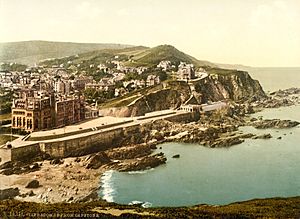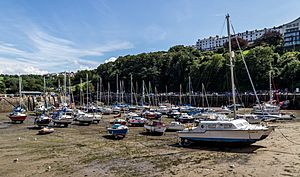History of Ilfracombe facts for kids
Ilfracombe is a historic town on the coast of Devon, England. It has been a home for people since the Iron Age, when ancient Celts built a hill fort on a place called Hillsborough.
The town's name might come from two places. One idea is that it comes from an old Anglo-Saxon name, Alfreinscoma, meaning "Valley of the sons of Alfred". Another idea is that it comes from Norse and Old English words meaning "The valley with the bad ford".
Contents
Early History of Ilfracombe
The manor house at Chambercombe in east Ilfracombe was mentioned in the 1086 Domesday Book. It was built by a Norman knight named Champernon. People say this old house is haunted! In 1738, someone living there found a hidden room, which was a big surprise.
Ilfracombe used to have two main parts. One was a farming area around the parish church called Holy Trinity, which is very old. The other was a fishing village right by the natural harbour. This harbour is protected by big rocks like Capstone and Compass Torrs.
Because of its natural harbour, Ilfracombe became an important safe port on the Bristol Channel. Ships could easily find shelter here. It also had busy trade routes with places like Kinsale and Tenby.
Ilfracombe played a role in history by helping kings with their ships. In 1208, it provided ships and men for King John to go to Ireland. Later, it sent a ship to help conquer the Western Isles of Scotland. The town also sent six ships and 79 men to help with the siege of Calais.
The building on Lantern Hill by the harbour, called St Nicholas's Chapel, was built in 1361. It is thought to be the oldest working lighthouse in the UK. A light has shone from there for over 650 years!
Many important navy families lived in Ilfracombe. The Bowen family was one of them. James Bowen was a master on a famous ship, HMS Queen Charlotte, during a big battle in 1794. He became a Rear Admiral and helped rescue the British army at Corunna. His younger brother, Captain Richard Bowen, also served in the navy and worked with Lord Nelson. He sadly died in battle. James Bowen's son, John Bowen, founded the first settlement in Tasmania in 1803, which later became Hobart.
There was once a wooden fortress overlooking the harbour, but nothing remains of it today. The area is now called Castle Hill.
The famous writer Fanny Burney visited Ilfracombe in 1817. She wrote in her diary about life there, including seeing a captured Spanish ship and two ships caught in a storm. She also had a close call when she was nearly trapped by the tide!
In the 1820s, miners from Wales carved four tunnels by hand. These tunnels made it easier to reach the beaches by horse-drawn carriage or on foot. Before this, people had to climb cliffs or go by boat. The tunnels led to two tidal pools. In the Victorian era, men and women used separate pools for swimming. These tunnels are still there today and are called Tunnels Beaches.
Until the mid-1800s, Ilfracombe's economy was mostly about the sea. It imported lime and coal from Wales and fished for herring. It also traded with places like West Africa and the West Indies. Many navy officers and sailors lived in the town during this time.
Ilfracombe's Railway Connection
From 1874, Ilfracombe had its own railway line that connected it to Barnstaple. This made it much easier for people to visit. However, the railway line closed in 1970.
Tourism in Ilfracombe
Ilfracombe slowly grew into a popular tourist spot, with ferries bringing visitors along the Bristol Channel. The railway opening made tourism grow even faster. The town's population increased a lot until the First World War.
During the busiest times for tourism in the 1950s, many holidaymakers came to Ilfracombe. Over 10,000 visitors used the railway every Saturday during the summer! Passenger ferries brought even more people. When cheaper package holidays to other countries became popular in the 1960s, and the railway closed, tourism in Ilfracombe slowed down.
Ferry Services
The first steamships arrived in Ilfracombe in 1823. Soon, there was a regular ferry service between Bristol and Swansea.
In 1873, a wooden pier was built. This allowed the pleasure steamers to dock at all times, no matter the tide. In 1894, a newspaper reported that over 2,500 people arrived on seven different boats! These boats were known for being fast and comfortable. They carried not only holidaymakers but also workers, animals, and goods to and from the town.
A famous ship called the PS Waverley started coming to Ilfracombe in 1887. The old wooden pier was damaged during World War II, so a new one was needed. A new pier made of concrete was opened in 1952, with more space for cars.
Lifeboat Station
Ilfracombe got its first lifeboat in 1828. A permanent lifeboat service started in 1866 when the Royal National Lifeboat Institution built a station near the pier. The current lifeboat station, which is very modern, was built in 1996.
Major Fires in Ilfracombe
Ilfracombe has experienced several large fires over the years, often because many of its old buildings were hotels built close together.
The Great Fire of Ilfracombe happened on July 28, 1896. It started in a furniture shop and quickly spread. The local volunteer fire brigade worked hard all night to put it out. Thirty-five buildings were destroyed. The fire brigade had very basic equipment back then, including a manual engine and one ladder. Later, the brave firefighters received medals for their efforts.
The same area of town had two more fires in the 1980s. One was in a paint store in 1981, which caused a lot of smoke. Another, larger fire happened in 1983 in a shopping arcade. This fire was very serious. The site of this fire later became the Candar sheltered apartments. Charles and Diana, as the Prince and Princess of Wales, officially opened these apartments in 1992.
Other notable fires in Ilfracombe include:
- The Beacon Castle in 1985.
- The Mount Hotel in 1991.
- The Hotel Cecil in 2001.
- An arcade on the seafront in 2004.
- The Cliffe Hydro in 2004 and 2005.
In 2006, a big fire broke out at the Montebello Hotel. Many fire engines and firefighters from across the area came to help. The fire spread to nearby buildings and completely destroyed the six-storey hotel. The street had to be closed for a while because of the damage.
These fires show the challenges of having many large, old buildings in a town. However, compared to the number of old buildings, major fires are not very common.
See also
- Ilfracombe Branch Line
- List of Ilfracombe people



